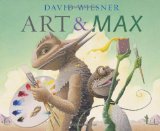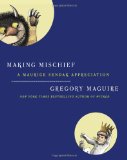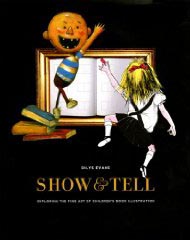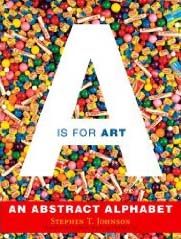Review of Art and Max, by David Wiesner
by David Wiesner
Clarion Books (Houghton Mifflin), Boston, 2010. 40 pages.
Starred Review
Three-time Caldecott Medal winner David Wiesner has another stunner here. Art & Max reminds me of The Three Pigs, because it’s also a meta-book, a book about how books are made. Or at least meta-art, art about art.
The story takes place in the desert with various desert reptiles. (I won’t attempt to specify which species.) Arthur is a big horny critter who is also an artist, and obviously very pleased with himself. When little Max comes along and wants to paint, he asks Art (Arthur) what he should paint.
When Art says, “You can paint me,” Max takes him literally. That’s when the fun begins.
Art ends up covered with paint. When the other critters try to fix him, he goes through several different manifestations — created in different art styles. Most catastrophic is when he’s a watercolor and drinks a glass of water — and then becomes a line drawing. Then when he walks away with Max holding his tail — he unravels completely.
Don’t worry, Max does recreate Art, in a whole new style.
I would like to share this with children. Probably old enough that they wouldn’t worry about being unravelled! Though I think kids will understand the playful spirit and that these things could only happen in a world where all the characters are made of paint in the first place.
This book has lots to talk about or just enjoy, and is captivating on many levels.
It wouldn’t have surprised me if this book had earned David Wiesner a fourth Caldecott Medal, since the art is so innovative and stunning. For me personally, the story didn’t have as much heart as his winners, but it’s still a playful and creative look at what you can do with art.
Find this review on Sonderbooks at: www.sonderbooks.com/Picture_Books/art_and_max.html
Disclosure: I am an Amazon Affiliate, and will earn a small percentage if you order a book on Amazon after clicking through from my site.
Source: This review is based on a library book from the Fairfax County Public Library.


 Show & Tell
Show & Tell